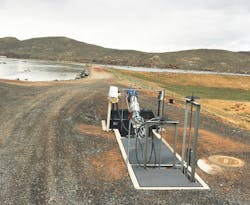Screening in a Hurricane
About the author:
Chris French is a freelance writer on water, environment and renewable energy issues. French can be reached at [email protected].
At a Utah facility that has seven wastewater treatment lagoons treating 1.5 million gal per day (mgd) and more than 300 acres of farm land, a new screen has immediately improved aerator reliability, with an added benefit of significantly improved system aesthetics.
Constructed in the early 1980s, the lagoons transitioned over the course of the next 20 years from facultative to aerobic lagoons with the installation of surface-mounted aerators. Due to the increasing use and disposal of wet wipes (“flushable” or “non-flushable”), Ash Creek Special Service District regularly struggled with mechanical breakdowns in their lagoon aeration system. An accumulation of wipes and rags would become bound around the aerator drive shafts, reducing performance until the motor became completely bound, resulting in an over-amp fault. A grinder installed for the purpose of shredding the rags proved ineffective because shredded rags and wipes recombined in the lagoon mixing areas and re-emerged as cords and ropes of the residual debris. Frustrated personnel at Ash Creek Special Service District (which serves the towns of Hurricane, La Verkin and Toquerville, Utah), were spending excessive amounts of time on maintenance while aeration performance in the lagoons was regularly impaired.
District staff began a process of site visits to wastewater plants in the area, requesting feedback from system operators on their satisfaction with screening performance at their facilities. Simultaneously, staff began identifying key requirements for the screening system that they would ultimately like to see implemented at the district’s facility.
These requirements included a very high capture efficiency, a full-penetration cleaning mechanism to eliminate the possibility of screen blinding, and a single integral screening/washer/compactor unit.
“We quizzed local engineers about perceived strengths of various screen types that they had seen implemented in facilities like ours,” said Mike Chandler, district superintendent. “That information, coupled with a strong endorsement from a neighbouring facility, pointed us in the direction of the inclined basket screen, and more specifically, Lakeside’s Raptor fine screen”.
Reduced Disposal Costs
Benefits of this screen include increased removal efficiency and low headloss, brought about by its cylindrical screenings basket, angled installation and screen bars of varied heights. Inorganic solids that can be harmful to downstream equipment are securely captured. The screen’s rotating rake teeth fully penetrate the cylindrical screen bars, positively removing debris and grease to prevent binding or plugging. Also suitable for septage receiving, sludge, scum and grease trap applications, the screen’s heavy-duty design provides durability and long life in severe conditions. Captured screenings are compacted, dewatered and washed free of most organics to approximately 40% solids. Volume is reduced by 50% and weight by 67%, thus reducing disposal costs.
Together, Ash Creek’s personnel worked with Lakeside’s Jim Aitkenhead and his team of engineers to design an influent receiving box and control structure that could be easily provided by a local supplier of precast concrete structures.
One month ahead of the arrival of the all-stainless steel Lakeside Raptor screen, the team at Ash Creek installed the control structure and screening channel. They also erected an electrical building and non-potable water air-gap tank for the screening washdown nozzles, and installed a screening structure washdown hose bib. Ash Creek’s operators later installed the fully assembled screen and worked closely alongside Lakeside during final commissioning.
When the upstream water level rises to a high level set point, the Raptor screen’s rake arm begins to rotate for removal of the captured material. After the rake arm makes a complete revolution, material falls into a collection trough. For complete cleaning, the rake arm reverses direction at the top of the screenings basket and passes through a hinged cleaning comb. The debris is removed from the collection trough by a central screw conveyor. The conveyed material travels up the inclined transport tube, where the material is washed, compacted and dewatered prior to being discharged into a debris container.
Made in the U.S., the screen’s hinged structural support allows the unit to pivot out of channel for inspection at floor level, whilst its simple drive assembly also makes service easy and further reduces maintenance costs.
Trouble-Free
“We made a minor adjustment on the new screen’s control floats, and the Lakeside Raptor has run totally trouble-free,” Chandler said. “The amount of rags and debris it removes has surprised us all here at Ash Creek. The washed and compacted screenings are also very low on odor, which has been a bonus.
“Overall, we can see what a tough and well-designed piece of equipment this is from Lakeside, who have clearly earned the recommendations we received from happy plant operators.”
SIDEBAR:
Natural Grass Mowers
It is not every day that you see goats at a wastewater treatment plant, but at Ash Creek Special Service District, there are more than 400 of them—and they certainly earn their keep.
The ever-increasing awareness of the general public requires more careful stewardship of environmental resources. Typically, careful attention to public health would require that in addition to treating and disposing of wastewater, a treatment entity not create any new nuisance in the process. Eliminating the threat of secondary pathogen carriers, namely mosquitoes, is a common challenge for wastewater professionals. In addition to effectively treating wastewater, staff at the district has made a conscious effort to reduce the amount of insecticide and herbicide used in eliminating the threat of mosquitoes. On the banks of the seven-lagoon system, the goats are put to work eliminating all shore line vegetation necessary for completion of the mosquito life-cycle, saving Ash Creek around $20,000 in chemical costs annually.
Raised by the district’s farm manager, Kim Spendlove, the goats graze freely in pastures between the lagoons and on the more than 300 acres of farmland maintained by the district. Natural birthing in the pastures maintains numbers to 175 nannies, and about 250 goats are sold on the market each February, bringing in close to $20,000 in additional income.
All effluent from the treatment lagoons is used to irrigate 300 acres of crops—including alfalfa, oats and triticale—which is another critical source of operating income for the district.
About the Author
Chris French
Chris French is a freelance writer on water, environment and renewable energy issues. French can be reached at [email protected].

